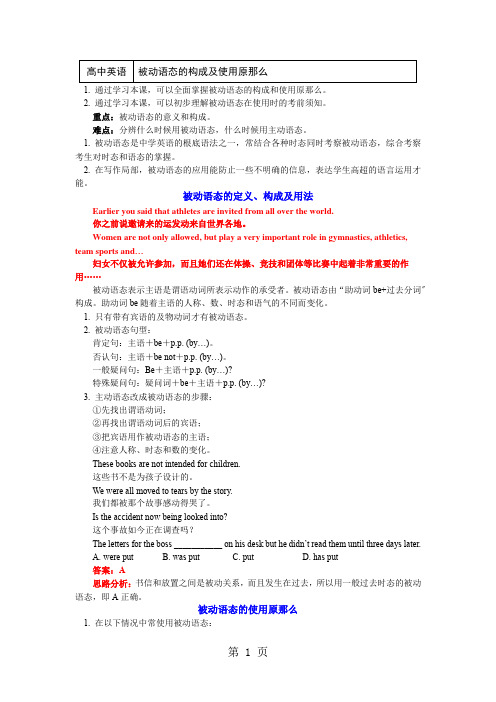高中英语-被动语态讲义
- 格式:docx
- 大小:28.73 KB
- 文档页数:8


1. 通过学习本课,可以全面掌握被动语态的构成和使用原那么。
2. 通过学习本课,可以初步理解被动语态在使用时的考前须知。
重点:被动语态的意义和构成。
难点:分辨什么时候用被动语态,什么时候用主动语态。
1. 被动语态是中学英语的根底语法之一,常结合各种时态同时考察被动语态,综合考察考生对时态和语态的掌握。
2. 在写作局部,被动语态的应用能防止一些不明确的信息,表达学生高超的语言运用才能。
被动语态的定义、构成及用法Earlier you said that athletes are invited from all over the world.你之前说邀请来的运发动来自世界各地。
Women are not only allowed, but play a very important role in gymnastics, athletics, team sports and…妇女不仅被允许参加,而且她们还在体操、竞技和团体等比赛中起着非常重要的作用……被动语态表示主语是谓语动词所表示动作的承受者。
被动语态由“助动词be+过去分词〞构成。
助动词be随着主语的人称、数、时态和语气的不同而变化。
1. 只有带有宾语的及物动词才有被动语态。
2. 被动语态句型:肯定句:主语+be+p.p. (by…)。
否认句:主语+be not+p.p. (by…)。
一般疑问句:Be+主语+p.p. (by…)?特殊疑问句:疑问词+be+主语+p.p. (by…)?3. 主动语态改成被动语态的步骤:①先找出谓语动词;②再找出谓语动词后的宾语;③把宾语用作被动语态的主语;④注意人称、时态和数的变化。
These books are not intended for children.这些书不是为孩子设计的。
We were all moved to tears by the story.我们都被那个故事感动得哭了。
Is the accident now being looked into?这个事故如今正在调查吗?The letters for the boss ___________ on his desk but he didn’t read them until three days later.A. were putB. was putC. putD. has put答案:A思路分析:书信和放置之间是被动关系,而且发生在过去,所以用一般过去时态的被动语态,即A正确。

2023年高中英语语法被动语态的主要用法被动语态的主要用法当不知道或没有必要指出动作的执行者时,常用被动语态,这时往往不用by短语。
The front window in the classroom was broken yesterday. 昨天,教室的前窗被打破了。
(不知谁打破的)They have been poorly paid. 他们的工资太低。
(没必要指出工资是谁付的)突出或强调动作的承受者,如果需要说出动作的执行者,用by 短语。
The time-table has been changed. 时间表已变动了。
(要突出的是“时间”)These books are written especially for children. 这些书是专门为孩子们写的。
(强调的是“”这些书)为了使语言得体或圆滑等不愿意说出动作的执行者。
如:You are requested to make a speech at next meeting. 请您在下次会议上作个发言。
It is said that she is going to be married to a foreigner. 据说她要嫁给一个外国人。
出于修辞的原因,或是说为了更好地安排句子。
如:It is generally considered impolite to ask one’s age, salary, marriage, etc. . 问别人的年龄、工资、婚姻状况等通常被认为是不礼貌的。
The notion is especially opposed to by those who have invested much in the area. 这个提议特别遭到了那些在本地区投资很大的人的反对。
(因those的定语太长了,若用它作主语,主语与谓语就相距太远而显得句子松散。
)8种常用时态的被动语态由“助动词be + 动词的过去分词”构成。



初升高衔接英语语法被动语态讲义【语法详解】高中英语语法中的被动语态是一个非常重要的概念,它用于描述主语是动作承受者的情况,即动作不是由主语发出的,而是施加于主语的。
掌握被动语态对于提高英语表达能力、阅读理解和写作都至关重要。
一、被动语态的基本结构被动语态的基本结构由“助动词be(的各种时态形式)+及物动词的过去分词”构成。
根据时态的不同,助动词be会有相应的变化。
1. 一般现在时被动语态•结构:am/is/are + done(过去分词)•例子:The book is read by many students.(这本书被许多学生阅读。
)2. 一般过去时被动语态•结构:was/were + done(过去分词)•例子:The window was broken by the wind.(窗户被风吹破了。
)3. 现在进行时被动语态•结构:am/is/are being + done(过去分词)•例子:The room is being cleaned now.(房间现在正在被打扫。
)4. 过去进行时被动语态•结构:was/were being + done(过去分词)•例子:The bridge was being built when the accident happened.(事故发生时,桥正在被建造。
)5. 现在完成时被动语态•结构:have/has been + done(过去分词)•例子:The book has been translated into many languages.(这本书已被翻译成多种语言。
)6. 过去完成时被动语态•结构:had been + done(过去分词)•例子:The work had been finished before he came.(他来之前,工作已经完成了。
)二、被动语态的用途1.不知道或无需指出动作的执行者:o The letter was posted yesterday.(昨天信被寄出了。
高中英语复习测试题-被动语态讲解及练习(一)语态分类:英语动词分主动语态和被动语态。
主动语态表示主语是动作的执行者,被动语态表示主语是动作的承受者。
Tom (执) cleans (谓动)the room (承) every day.(主动)The room (承)is cleaned (谓动) by Tom (执) every day. (被动)被动语态结构: 助动词 be + 动词的过去分词 done , 即 be done ,常译为 被”、给”、由”、受”等词用来表示被动关系。
(二) 被动语态的用法(1)动作的执行者很明显。
这时往往不用 by 短语。
Some skills are taught in our computer less ons. (2) 不知道或没有必要说明动作的执行者是谁。
Some new computers were stole n last ni ght.(3)突出或强调动作的承受者。
如果需要说出动作的执行者,用by 短语。
The wi ndow was broken by Mike.窗户是迈克打破的。
(三) 被动语态的时态变化:通过助动词 be 的各种时态变化来体现, done 不变。
注意主语的单、复数变化。
以do 为例,掌握下列时态的被动结构,形式变化如下:1.一般现在时: am / is / are + done2 •—般过去时:was / were + done 3.—般将来时:shall / will + be doneam/is/are going to be done4.现在完成时:have / has + bee n + done5.情态动词:can/may/must/should/have to be done以下时态的被动语态作一般了解:现在进行时: am / is / are + being + done 过去进行时: was / were + being + done 过去完成时:had + bee n + done过去将来时:should / would + be doneMy aunt in vited me to her dinner party.执行者 动词 承受者was in vited (by my aunt ) to her dinner party.(四)主动语态变被动语态的方法I承受者谓语by+执行者1•把主动语态的宾语变成被动语态的主语。
2•把主动语态的谓语变成被动语态的be +过去分词,时态要与原句保持一致。
3•把主动语态的主语变为介词by的宾语,放在被动语态里谓语动词之后,by短语可以省略。
练习:1. 一般现在时:People grow rice in the south of the country.___________________________ in the south of the country.2. 一般过去时:Nancy Jackson desig ned the CD-ROM.The CD-ROM ___________________________ Nancy Jacks on.3. 一般将来时:They will hold the charity show in the school hall.The charity show ___________________________ in the school hall.4. 现在完成时:He has brought his book here.His book ___________________________ here.5. 含有情态动词的被动语态:You must hand in your homework after class.Your homework ____________________________________ after class.(五)语态转换时所注意的问题1. 把主动语态变为被动语态时,先找原主动句中的动宾短语,其谓语动词的时态要与原句时态保持一致,其谓语动词的数要与新主语保持一致。
We have bought a new computer.A new computer has bee n bought.(正确)A new computer have been bought. (错误)2. 含有双宾语的主动句变被动句时,可分别将其中的一个宾语变为主语,另一个不动,一般变间接宾语为主语。
My uncle gave me a present on my birthday.I was give n a prese nt on my birthday.如果把直接宾语(指物)改为主语,则在间接宾语(指人)前加适当的介词,如上句还可说:A present was given to me yesterday.注意:1.下列动词后,常在间接宾语前用介词to,如:bring, give, lend, offer, pass, show, teach, tell 等。
⑴ The book was show n to the class.(2) My bike was lent to her.2. —般在下列动词后,间接宾语前用介词for,女口:buy, cook, get, keep, make, order, play, sing 等。
(1) A new skirt was made for me.(2) The meat was cooked for us.(3) Some country music was played for us.3. 由动词+介词或副词构成的短语动词,要把它们作为整体看,介词或副词不可拆开或漏掉。
这类动词有: 动词+ 介词,女口: laugh at, listen to, look after, think of, talk about, work on 等。
动词+ 副词,女口: sell out, find out, give up, hand in, work out, pass on, point out, put away, put off, think over, turn on, wake up 等。
The most difficult problem was worked out by Tom.The song is ofte n liste ned to by girls.4. 带复合宾语(宾语+宾补)的动词改为被动语态时,把主动结构中的宾语改为主语,而宾语补足语保留在谓语动词后面。
如:(1) We always keep the classroom clean.(keep sth. clea n)T The classroom is always kept clea n. (sth be kept clea n)(2) She told us not to stay up late. (tell sb not to do …)T We were told not to stay up late . (sb. be told not to do …)注意:在see, watch, hear, notice, listen to, look at, make, feel等动词后作宾语补足语的动词不定式都不带 ______ 9, 但改成被动语态后都补上to。
We ofte n hear him play the guitar. T He is ofte n heard to play the guitar.记住下列变化:see sb do …be see n to dohear sb do be heard to doliste n to sb do be liste ned to to domake sb do …be made to do5.有些动词既可作及物动词,也可作不及物动词,当它们和well, badly, easily等副词连用时,表示主语内在品质或使用性能,是不及物动词,不用被动语态,常见的有: write, read, clean, sell, wash, cook等。
如:(1) The cloth washes easily. 这布很好洗。
(2) The new computer sells well. 这新产品很畅销。
(3) The printer prints quickly. 这个打印机打印很快。
对比:The books sell well. ( 主动句)The books were sold out. (被动句)6. 只有动宾结构才有被动语态。
下列情况的主动句不能改为被动句:第一,感官连系动词无被动意义,如:feel, look, seem, taste, sound, smell 等。
(1)—Do you like the material? —Yes, it feels very soft.误:It is felt very soft.(2)The food tastes delicious.误:The food is tasted delicious.(3) The pop music sounds beautiful.误:The pop music is sounded beautiful.第二,一些不及物动词短语没有被动语态,如:take place, break out, belong to, come out, come true 等。
如:The accident took place last night.误:The accident was taken place last night..第三,不及物动词没有被动语态,如:rise, h appe n, succeed, lie等。
The sun has already risen.误:The sun has already been risen.第四,宾语是反身代词,相互代词,同源宾语,不定式,v-ing 形式及抽象名词等,不能变为被动句子的主语,如:I taught myself English.误:Myself was taught English.7. 在汉语中,有一类句子不出现主语,在英语中一般可用被动结构来表示,例如:据说 ... It is said that …据报导 ... It is reported that it is going to rai n tomorrow.众所周知…… It is well known that Thomas Edison invented the electric lamp.8. 注意区别系表结构(be+adj.)和被动语态。